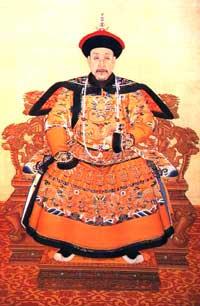During the Qing Dynasty, China was ruled by the Manchus, a tribe of foreigners from northeastern China. The reigns of the first three emperors, which lasted for 133 years, were a time of peace and prosperity for China. The Qing Dynasty adopted the form of government used during the Ming Dynasty with only minor adjustments. All positions were held jointly by one Manchu and one Chinese, with the Manchu having more power. The form of military organization that the Qing used was one of the best in the world. They organized their troops under banners, each of which was a separate unit. These fighting men were owned by the emperor, and they were incredibly loyal to him. The banner men also functioned as a talent pool from which civil bureaucrats could be chosen.
The Qing were very successful as foreign rulers in China. They maintained their domination of the Chinese while preserving their own identity. They spent their summers in their homeland of Manchuria, which was closed to the Chinese. They banned intermarriage with the Chinese, continued to speak their own language and did not make their documents available to the Chinese. They retained military strength over the Chinese by separating the duties of the Chinese troops and of the Manchu troops.
The Qing instituted changes in the dress of the Chinese. They required Chinese men to shave their heads and wear queues. They also required them to wear Manchu clothes. Chinese women were forbidden to bind their feet. This proved impossible to enforce and in 1668 the ruling was withdrawn.
The period of peace that followed the ascension of the Qing Dynasty allowed for growth in all areas. Public works were repaired and maintained. Taxes were very light as compared to previous dynasties, and if famine struck, taxes were reduced even further. Commerce and international trade grew. This peace allowed for a revival of arts and learning
Porcelain production continued to be important and new colors, such as shades of green, and compositions of black and yellow, were developed. A dark blue and brilliant red were also used. Painting was important, and for the first time European influences were seen. For the first time, European missionaries were allowed into China and influenced Chinese ideas about science.
of green, and compositions of black and yellow, were developed. A dark blue and brilliant red were also used. Painting was important, and for the first time European influences were seen. For the first time, European missionaries were allowed into China and influenced Chinese ideas about science.
During the reign of Qianglong, the borders of China were expanded to their greatest extent ever. His reign was the time of the greatest prosperity during the Qing Dynasty. But, there were also signs of internal problems. Popular uprisings occurred and though the government succeeded in suppressing the uprisings, they did not alleviate the impoverishment that had led to them.
The influence of the west was also felt for the first time in China. Great Britain especially was interested in trading with China for silk and tea. However, the British did not have anything to import to China until they began importing opium. This was devastating to China. Many Chinese became addicted to opium, and land that had previously been used for food began to be used to produce opium.
Also, a large amount of Chinese money left the country in payment for the opium. Finally, in 1839 the opium trade was abolished. This set off a war with Great Britain that came to be known as the Opium Wars, and in 1842 China was forced to sign a treaty in which Great Britain received Hong Kong, and ports were opened to European trade.
Internal rebellions further weakened China. The T'ai P'ing rebellion is one of the most famous. Other uprisings and problems caused by internal rebellion were further intensified by Japanese aggression. Russia too began to come into contact with China and treaties were signed which defined the China/Russia border and allowed for trade.
While these struggles were occurring, the emperors became younger and younger and the government was in the hands of empresses and other advisors. The empress who held the most power was Tzu Hsi. She was uneducated and opposed to any type of reform or modernization that might have helped China economically and politically. Reformers who felt that China had to change were executed. Tzu Hsi had the former emperor executed, and the next day she too died, albeit of natural causes. However, before her death she placed a two year old on the throne. This further weakened the government and strengthened the revolutionaries. Nineteen-eleven marked the end of the Qing Dynasty.
